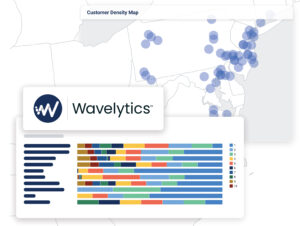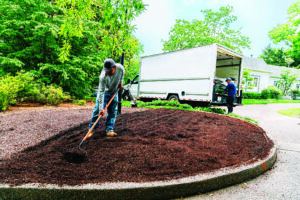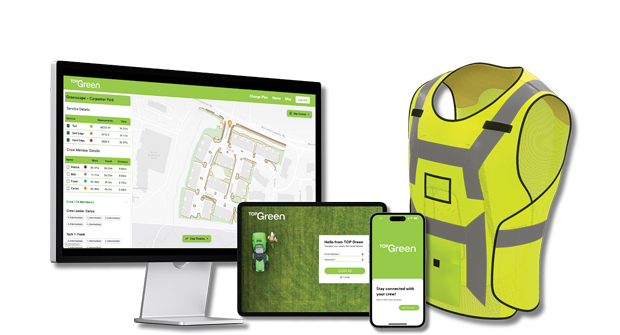Business software has become as indispensable to today’s landscape contractors and lawn care operators as zero-turn mowers, skid-steers and backpack sprayers.
Today’s business software platforms — especially those designed to address processes and procedures used by landscape industry pros — provide users the ability to overcome common challenges like resource allocation and time management while empowering owners and managers to be more efficient, data-driven, customer-centric and, ultimately, more profitable.

Marty Grunder has seen it all in his four decades as owner of Dayton, Ohio-based Grunder Landscaping Co. and as an industry coach through his consulting firm, The Grow Group. That includes some professional landscape and lawn care firms that insist on staying low-tech, often with older, outdated legacy business systems that struggle to meet modern needs and standards. Or, he adds, some pros shun technology altogether and still prefer pen-and-paper methods.

Business management software, such as RealGreen by WorkWave, can help with a variety of tasks, including scheduling, managing customer relations, communication and much more. (Photo: Workwave)
“I just don’t get it. I really don’t get it,” Grunder says. “I know there’s some heartache involved when switching over from paper to non-paper processes, but it’s totally worth it. It boils down to whether you want to succeed with your business. Sometimes, you have to put your head down and do the worst of things to get things moving in the right direction.”
Grunder can testify firsthand to a modern business software platform’s impact on a landscape operation. Grunder Landscaping upgraded to Aspire’s cloud-based comprehensive business management platform five years ago. He says it streamlined his operations, improved efficiencies and provided him with the tools to boost his annual revenue from $4.5 million at that time to $18 million today.
“Companies still do business with people they know, like and trust,” Grunder says. “Technology should be an element that helps customers like and trust you more.”
Landscape and lawn care pros and software developers serving the industry voice their expert insights and thoughts on how these essential platforms address critical green industry challenges, streamline operations and drive growth.
Scheduling and beyond
For landscape and lawn care contractors, the core functionalities of scheduling and invoicing aren’t just features — they’re the driving force behind investing in a business management platform.
These fundamental capabilities are essential to bring order to daily operations and ensure consistent cash flow, making them the initial, nonnegotiable benefits that compel industry pros to take the leap with new technology.

At the root of all business software’s functionality is greater operational proficiency, says Michael Carden, senior product manager at RealGreen by WorkWave. The Holmdel, N.J.-based company’s business-in-a-box software solution streamlines operations, manages customer relationships and helps direct strategic growth.
“Business owners should be looking at (business software) and asking how they can become more efficient,” he says. “What tools can I use to help not only the business drive efficiency but also every single employee in the operation? How can they become more efficient, and how can we grow? And it’s a marvelous time in technology to help answer those questions.”
Before adopting Aspire’s platform in 2018, Sun Valley Landscaping in Omaha, Neb., relied on a magnetic scheduling board and reams of paper, an archaic system that made tracking anything accurately nearly impossible.
Adopting the software platform was instrumental in clarifying Sun Valley’s indirect job time and production rates. Previously, it would take a week to sift through a three-inch packet of handwritten data sheets to build a job costing and product rate system, says Paul Fraynd, Sun Valley’s owner. This manual, error-prone process made accurate job costing and production rate analysis a nightmare.

“You buy (a business management software), and you just can’t help but have good habits,” Fraynd says. “It allowed us to keep track of this to pay your payroll, which feeds into your job cost time and lets you update your production rates so that you can correct your contracts going forward. So, it was a big change … but it opened a lot of opportunities for us, too.”
And it’s been a game-changer for Sun Valley’s lead management. According to Fraynd, web-based lead forms are automatically integrated, enabling instant follow-up and significantly boosting their response time to clients.
“In today’s fast-paced world, merely answering the phone can set you apart, but only if you have a system to manage those interactions effectively,” Fraynd says. “Our unified communication platform — utilizing cell phones, office phones and a Webex Connect system — ensures seamless communication. Our CRM centralizes all communication, providing a comprehensive history of every customer interaction. This client communication functionality is, arguably, the most crucial aspect of our technological evolution.”
Integrating modern business management software revolutionized the company’s operations and paved the way for integrating other critical software tools. Beyond client-facing advantages, Fraynd says fleet tracking has provided immense internal benefits, such as tracking vehicle locations and meticulously recording maintenance schedules, mileage and fuel consumption for Sun Valley’s fleet of trucks and equipment.
Riding the AI wave
Software developers readily admit that weighing business management software options can be complex and confusing for novices, as the process is often inundated with an alphabet soup of terms like ERP (enterprise resource planning) and CRM (customer relationship management). To clarify, ERP systems focus on back-office processes and operations, while CRMs focus on front-office services like managing customer interactions. Integrating the two can yield significant efficiency gains and enhanced business outcomes for landscape pros.
According to Carden, management features like routing, customer communication and payment processing have been the cornerstones of any effective software package, and leveraging these core capabilities is critical for contractor growth. However, software experts point out that other powerful new functions can significantly impact growth, efficiency and market competitiveness.

San Francisco-based Bobyard, an artificial intelligence (AI)-powered estimation platform, dramatically streamlines a significant pain point for landscape contractors. According to chief of staff Haley Hineman, this innovative software automates the traditionally manual, painstaking and time-consuming process of counting shrubs, measuring piping and calculating square footage, thereby significantly reducing labor hours.
“We help automate (those tasks) and help contractors focus on higher-level human tasks that only humans can do,” Hineman says. “We’re basically using computer vision to analyze and understand blueprints.”
Effective software development and new functionality for the landscape and lawn care industry is deeply rooted in direct contractor feedback. Software developers emphasize that this collaborative, voice-of-customer approach is pivotal in ensuring new features directly address critical, real-world operational challenges.
As a testament to this, Bobyard’s upcoming updates are a direct result of contractor input: It rapidly and precisely extracts specific square footage for planting areas, significantly boosting efficiency in a crucial yet tedious aspect of their work.
“That is such a headache for contractors,” Hineman says. “They have to click ab
out 100 times around a certain area of a digital blueprint to understand mulch area, for example, or maybe sod for a lawn. So why are they clicking 100 times? Let’s help automate that and give (the data) to them in one click.”
According to software developers, adopting and integrating AI is not just a trend but a fundamental shift toward smarter, more adaptive and data-driven solutions. As a result, AI is making business software smarter through more intelligent, autonomous, efficient and user-centric solutions for landscape contractors that will provide significant competitive advantages in their businesses.
“You’re seeing a whole wave of LLMs (large language models, powerful AI tools that automate tasks) and very specific AI for industries like landscaping,” Hineman says. “That’s exciting because that will move the needle a lot and save tons of hours.”
Number crunching

A key game-changer with today’s business software is the ability to compress the number of steps involved in routine information-gathering tasks. Instead of keying data manually, it’s more efficient to collect that data autonomously, says Drew Wagner, founder and CEO of Mount Pleasant, S.C.-based LaunchPad. The software platform automates and streamlines various aspects of a landscape or lawn care business, from initial lead capture and property measurement to quoting, client communications and invoicing, leveraging advanced technologies to improve efficiency and customer satisfaction.
“The biggest thing we hear over and over is they want to have a good picture of where their costs sit so they can price accurately,” Wagner says. “So, on our mapping side, with the tools we’ve created … we’re enabling (landscape pros) to know their numbers. That’s the reason someone chooses to use business management software. They want to be more profitable and efficient. It’s the No. 1 reason people want to use these platforms.”
In addition to more deeply linking landscape pros with their business operations and their customers, developers say business software must also provide a critical conduit for field crews — the true eyes on the ground.
“You need that ability to communicate data seamlessly, whether through photos, texts, voice or annotations,” Wagner says. “It just makes it easier when you have that kind of visualization to make decisions. What do the conditions on the ground look like? What special things might I need to know beyond those numbers that are custom to that piece of property?”
Analytics: Smashing data
Today’s software solutions provide industry pros with robust reporting tools that collect, extrapolate and analyze data to identify trends and inform strategic decision making. What makes this so attractive is that by understanding customer behavior, sales tendencies and operational efficiencies, owners and managers pinpoint areas for improvement and more efficiently gauge effectiveness across sales, marketing and in-the-field operations.
Beyond exceptional leadership, Grunder says data analysis drives business success. Shrewd managers leverage timely information to make astute decisions. He says that without a data aggregator providing owners and managers with a pulse on performance, a landscape business will inevitably fall short of its potential.
“It’s like going to a (baseball) game, and there’s no scoreboard,” Grunder says. “They’re not keeping score. They’re just playing for fun. Well, businesses don’t work like that. … And if you don’t know what to do more of and what to do less of, you’ll never improve. It’s impossible.”
According to software developers, landscape’s newest generation of owners and managers is focused intensely on analytics and how to leverage that data for growth and improvement. As a result, it’s giving them an edge over technology-adverse veteran players.
“There’s a new wave of things happening with these younger guys in the industry who are really sharp about software,” Hineman says. “It’s giving them a certain confidence in business that is interesting and cool to see.”
Those same developers think that integrating AI with machine learning and operational analytics can revolutionize business software development. This empowers the software to deliver contractors deeper insights into their business health, identify opportunities for enhanced cost and time efficiency and pinpoint crucial areas for growth.
Top Green by Turing is one example of software addressing contractor needs by leveraging data analytics. The software digitizes crew planning and execution, increasing on-site efficiency. Top Green employs a unique GPS detector and a beacon embedded in crew members’ safety vests to track movements and equipment usage in real time and report that information to owners and managers.

According to Top Green’s Sashikumar Yeddnapudi, the company’s chief revenue officer, landscaping companies strive for a comprehensive understanding of their businesses, particularly in operations, which are the core drivers of their success. However, many current processes remain manual despite a shift toward software and digital tools. Yeddnapudi sees a critical gap emerge once the sales team secures a project and hands it over to operations to deliver the final product.
While high-level scheduling and planning software orchestrates crew movements and equipment needs, Yeddnapudi says those platforms can fall short of providing owners and managers the precise operational visibility and transparency necessary for optimal performance.
However, labor isn’t to blame. Instead, Yeddnapudi believes it’s a systemic flaw in the processes, and detailed analytics, viewed in a real-time format, address this challenge. For example, a common scenario involves a crew assigned to a property with a two-hour budget for mowing, trimming and blowing. Despite their experience, the lack of a precise action plan leads to inefficiencies and more time on-site to complete the work. As a result, the contractor’s margins shrink.
“So, instead of guessing, we wanted technology to enable this process seamlessly,” he says. “Start with a plan. This is the property, and these are the five activities you want to perform. Input this into the system, and the technology runs a plan.”
While detailed planning is crucial, Yeddnapudi acknowledges the inherent differences between computer-generated plans and real-world execution. Factors like property nuances, obstructions and walking distances significantly impact production times, making accurate calculation difficult. Traditional methods of gauging actual time are not scalable for landscape pros. This is where the data gleaned from real-time production mapping is invaluable for identifying where a crew is lagging and where efficiencies can be gained.
“If we don’t know the actual production details, then you cannot make a better plan,” he says. “So, the trackable vest helps us to map the production in real-time. We know from the time crews check into the property how much time they take for each service.”
Similarly, in 2025, WorkWave soft-launched Wavelytics, a dedicated analytics and AI platform business unit. According to Carden, the core principle is that “what gets measured gets improved.”
This encompasses every facet of green industry business, not solely operations, and gets that data into owners’ and managers’ hands. Carden says it extends to scrutinizing how marketing campaigns are doing, understanding client retention and identifying and anticipating customer trends.
Carden emphasizes that analytics have an immense impact on the day-to-day operations of landscape businesses: “Again, it’s understanding critical key performance indicators (KPIs) and using those KPIs to target where improvements need to be made,” he says.
A satisfied customer
Customer satisfaction is a conundrum often referred to as the “Amazon Effect.” At its core, it reflects the customer’s decades-long demand for speed, convenience and a personalized purchasing experience from the companies they patronize.
For the green industry, customer satisfaction is no longer solely driven by service delivery, RealGreen’s Carden says. Instead, customers weigh their overall experience with companies they do business with, including maintenance and lawn care.
“Homeowners, obviously, want to be informed,” he says. “They expect easy access to information and the services you’re performing for them. They want to feel connected.”
An effective software platform does just that, Carden says, enhancing the contractor’s ability to communicate with clients and ultimately allowing them to manage service expectations better and increase profitability.
LaunchPad’s Wagner agrees, adding that meeting customer demands for transparency requires immediate access to upcoming service dates, recent payment history and other critical information.
Likewise, Wagner states that equipping contractors with AI systems to instantly scour vendor and supplier sites for material availability and real-time pricing enables faster, more accurate job quotes and fosters the transparency customers increasingly demand from service providers.
Fraynd believes operating with a modern business management system allows them to engage with higher-caliber professional clients who want to do business with industry leaders. For example, larger commercial clients mandate that their landscape contractors operate with GPS functionality, precise tracking of when crews clock in and out and sophisticated safety assurances.
“In the eyes of clients, this level of professionalism transcends the image of us being just ‘guys mowing lawns,’” he says. “I’m passionate about professionalizing our industry, and this is where you start. It’s the reason why private equity and larger companies are able to take more market share; they use technology. So, if you want to service large corporate clients, then you need to start with these basic tools.”
Bridging the labor gap
The pervasive issue of labor scarcity presents a significant hurdle for landscape and lawn care businesses. Business management software plays a vital role in mitigating this issue by maximizing existing staff efficiency and reducing the reliance on labor to tackle administrative tasks.

Imagine a commission salesperson, says Marty Grunder, driven to close deals, hampered by antiquated methods and obsolete technology. Instead of leveraging cutting-edge software, sales manually measure jobsites with a wheel — a time-consuming and remarkably inaccurate practice. This starkly contrasts with a software solution that seamlessly enables digital measurements.
“Now, you’re generating quotes that took five, six or seven hours in 10 minutes,” Grunder says. “Start thinking about how many more jobs a salesperson can sell, how much more money they can make and how much more time they can spend tending to clients.”
If software technology can compress a business process, then contractors should consider the immense frustration and wasted effort that can be mitigated, Grunder adds. Empowering teams with tools that simplify their lives directly translates into greater productivity, enhanced client satisfaction and a more prosperous business.
A recurring myth, often debunked by software developers, claims that modern software platforms and AI will eliminate landscape and lawn care jobs. Instead, developers clarify that these systems are designed to augment existing workforces, providing contractors with advanced digital tools to achieve more with their current staff. Rather than job displacement, AI enables owners and managers to strategically reallocate employees to new opportunities and address previously underserved areas.
“(Bobyard) saves the estimators hours on doing the bidding so that they can focus on other higher-level tasks, like finding better production rates, or project managing better or submitting more bids, winning more jobs,” says Bobyard’s Haley Hineman. “We’re not here to take jobs away. We’re here to allow contractors to save money and increase their ROI and profitability with the same headcount. So, it’s really a win-win for everybody.”
According to Grunder, another critical factor to consider is that the next generation of talent — those individuals entering the landscape and lawn care industries — expect businesses to utilize modern software platforms to manage their businesses.
“Guys that age don’t want to come in and be handed a piece of paper,” Grunder says. “They want to be able to do things digitally. I don’t think contractors always realize the impact of technology in making the work easier on the team and making (young talent) want to stay and work at your company.”
Paul Fraynd with Sun Valley Landscaping agrees, adding he often encounters stressed-out, overworked landscape owners who claim they lack the time to integrate technology to help run their businesses. Yet, clinging to outdated methods guarantees perpetual stress.
“They say they don’t have time to adopt the technology, which means they never have time to get in control of their businesses,” he adds. “It’s imperative to make this happen because if you want to live a happy life as a business owner, then business management software is the easiest way to do that.”


